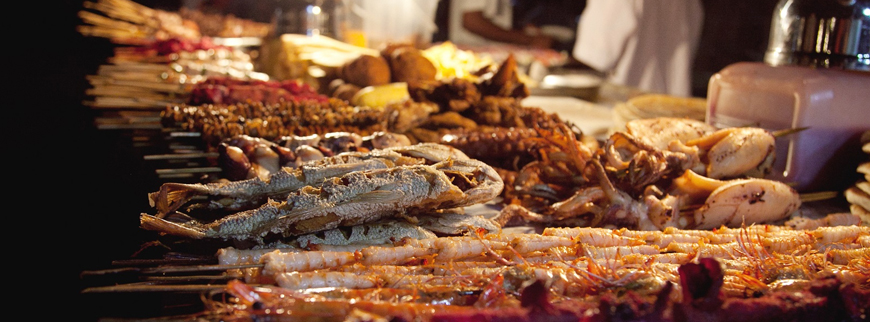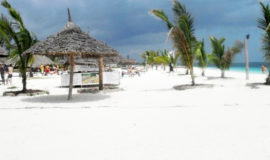
Zanzibar Culture and History
The presence of microliths suggests that Zanzibar has been home to humans for at least 20,000 years, which was the beginning of the Later Stone Age.
A Greco-Roman text between the 1st and 3rd centuries, the Periplus of the Erythraean Sea, mentioned the island of Menuthias (Ancient Greek: Μενουθιάς), which is probably Unguja. Zanzibar, like the nearby coast, was settled by Bantu-speakers at the outset of the first millennium. Archaeological finds at Fukuchani, on the north-west coast of Zanzibar, indicate a settled agricultural and fishing community from the 6th century CE at the latest. The considerable amount of daub found indicates timber buildings, and shell beads, bead grinders, and iron slag have been found at the site.
There is evidence for limited engagement in long-distance trade: a small amount of imported pottery has been found, less than 1% of total pottery finds, mostly from the Gulf and dated to the 5th to 8th century. The similarity to contemporary sites such as Mkokotoni and Dar es Salaam indicate a unified group of communities that developed into the first center of coastal maritime culture. The coastal towns, including those on Zanzibar, appear to have been engaged in Indian Ocean trade at this early period. Trade rapidly increased in importance and quantity beginning in the mid-8th century and by the close of the 10th century Zanzibar was one of the central Swahili trading towns.
Excavations at nearby Pemba Island, but especially at Shanga in the Lamu Archipelago, provide the clearest picture of architectural development. Houses were originally built with timber (c. 1050) and later in mud with coral walls (c. 1150). The houses were continually rebuilt with more permanent materials. By the 13th century, houses were built with stone, and bonded with mud, and the 14th century saw the use of lime to bond stone.
Only the wealthier patricians would have had stone and lime built houses, the strength of the materials allowing for flat roofs, while the majority of the population lived in single-story thatched houses similar to those from the 11th and 12th centuries. According to Tom Middleton and Mark Horton, the architectural style of these stone houses have no Arab or Persian elements, and should be viewed as an entirely indigenous development of local vernacular architecture. While much of Zanzibar Town's architecture was rebuilt during Omani rule, nearby sites elucidate the general development of Swahili, and Zanzibari, architecture before the 15th century.
Persian, Indian, and Arab traders used Zanzibar as a base for voyages between the Middle East, India, and Africa. Unguja, the larger island, offered a protected and defensible harbor, so although the archipelago offered few products of value, traders settled at Zanzibar City ("Stone Town") a convenient point from which to trade with the other Swahili coast towns.
The impact of these traders and immigrants on the Swahili culture is uncertain. During the Middle Ages, Zanzibar and other settlements on the Swahili Coast were advanced. The littoral contained a number of autonomous trade cities. These towns grew in wealth as the Swahili people served as intermediaries and facilitators to local, Arab, Persian, Indonesian, Malaysian, Indian, and Chinese merchants. This interaction contributed in part to the evolution of the Swahili culture, which developed its own written language.
Although a Bantu language, the Swahili language as a consequence today includes some elements that were borrowed from other civilizations, particularly loanwords from Arabic. With the wealth that they had acquired through trade, some of the Arab traders also became rulers of the coastal cities.
Vasco da Gama's visit in 1498 marked the beginning of European influence. In 1503 or 1504, Zanzibar became part of the Portuguese Empire when Captain Ruy Lourenço Ravasco Marques landed and demanded and received tribute from the sultan in exchange for peace.:page: Zanzibar remained a possession of Portugal for almost two centuries. It initially became part of the Portuguese province of Arabia and Ethiopia and was administered by a governor general. Around 1571, Zanzibar became part of the western division of the Portuguese empire and was administered from Mozambique.:page: It appears, however, that the Portuguese did not closely administer Zanzibar.
The first English ship to visit Unguja, the Edward Bonaventure in 1591, found that there was no Portuguese fort or garrison. The extent of their occupation was a trade depot where produce was purchased and collected for shipment to Mozambique. "In other respects, the affairs of the island were managed by the local 'king', the predecessor of the Mwinyi Mkuu of Dunga.":page: 81 This hands-off approach ended when Portugal established a fort on Pemba Island around 1635 in response to the Sultan of Mombasa's slaughter of Portuguese residents several years earlier. Portugal had long considered Pemba to be a troublesome launching point for rebellions in Mombasa against Portuguese rule.
The precise origins of the sultans of Unguja are uncertain. However, their capital at Unguja Ukuu is believed to have been an extensive town. Possibly constructed by locals, it was composed mainly of perishable materials.
Culture
A view of the clock tower in House of Wonders through Islamic styled door in the Stone City of Zanzibar.
ZIFF, 2013
Zanzibar's most famous event is the Zanzibar International Film Festival, also known as the Festival of the Dhow Countries. Every July, this event showcases the best of the Swahili Coast arts scene, including Zanzibar's favorite music, Taarab.
Important architectural features in Stone Town are the Livingstone house, The Old dispensary of Zanzibar, the Guliani Bridge, Ngome kongwe (The Old fort of Zanzibar) and the House of Wonders.The town of Kidichi features the Hamamni Persian Baths, built by immigrants from Shiraz, Iran during the reign of Barghash bin Said.
Zanzibar also is the only place in Eastern African countries to have the longest settlement houses formally known as Michenzani flats which were built by the aid from East Germany during the 1970s to solve housing problems in Zanzibar





